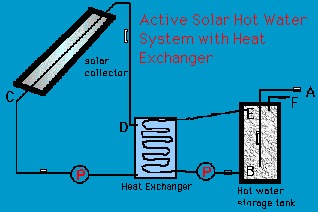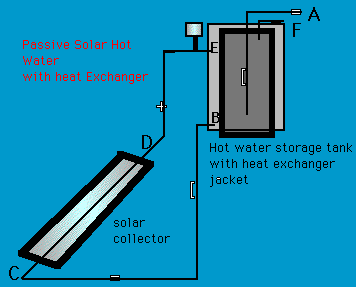Types of Solar Water Heaters: An Introduction
Over a million homeowners and nearly a quarter of a million businesses in almost all climates across the United States use solar devices for their water-heating needs. In summer months, in most parts of the country, a solar system for a residential building can meet 100% of the water-heating requirements. In winter months, the system may meet only half the water-heating requirements; therefore, a backup heat source supplements the solar system. The following discussion introduces the two types of solar water heaters and the three basic types of solar collectors used in those heaters.
Solar Water Heaters: Basic Types
There are two broad categories of solar water heaters: active and passive. The essential difference is method used to circulate water.
Active solar water heaters. Active solar water heaters use pumps to circulate water or some other fluid from the collectors, where it is heated by the sun, to the storage tank, where the water remains until needed. Active systems fall into two general groups based on freeze protection: those using a fluid with a low freezing point (such as propylene glycol) in the collector loop and those using water in the loop (which is automatically drained when the sun is not shining).

|
 |
Active (left) and passive (right) solar water-heating systems. Mr. Solar. Solar Water Heater. http://www.mrsolar.com/arthotwater.html
Passive solar water heaters. Passive solar water heaters, which rely on gravity, are typically either integral collector/storage (ICS) systems or thermosyphon systems. The major advantage of these systems is that they don't use controls, pumps, sensors, or other mechanical parts, meaning that only minimal maintenance is required during their lifetime. They are less expensive than active solar systems and can only be used in warm sun-belt climates. Also, the roof structure must be able to support the load of the storage tanks used in passive systems.
Solar Collectors: Basic Types
One of three types of solar collectors can be selected for solar water-heating systems: flat-plate, evacuated-tube, and parabolic collectors.
Flat-plate collectors. A flat-plate collector is basically a panel-shaped box containing fluid-filled tubes mounted on a dark-colored absorber. Suitable for both residential and nonresidential use, it can also operate well in a humid climate, where haze creates more diffuse, rather than direct, sunlight.
Evacuated-tube collectors. In an evacuated-tube collector, side-by-side tubes hold the fluid to be heated. Each tube is surrounded by an outer glass tube, and a vacuum between the inner and outer tubes provides good insulation to reduce heat loss. The collector operates at high temperatures with high efficiency using direct and diffuse light.
Parabolic-trough collectors. A parabolic-trough collector consists of a long U-shaped mirror that focuses the sun onto a fluid-filled tube along the center of the U-trough. This highly efficient system typically tracks the sun and requires direct, not diffuse, sunlight. The major use has been nonresidential or institutional applications such as prisons and hospitals.